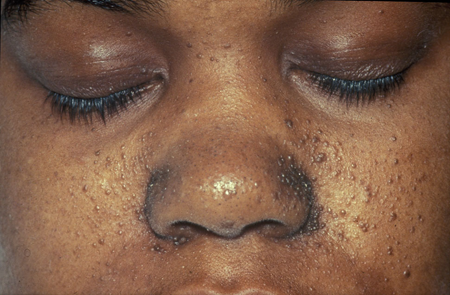If you’re preparing for the United States Medical Licensing Examination® (USMLE®) Step 1 exam, you might want to know which questions are most often missed by test-prep takers. Check out this example from Kaplan Medical, and read an expert explanation of the answer. Also check out all posts in this series.
This month’s stumper
A 4-year-old girl with an intellectual disability and seizures develops repeated episodes of syncope. Physical examination demonstrates numerous 1-5 mm erythematous papules distributed across the bilateral malar eminences. Echocardiogram shows a mass in the left ventricle. The mass is resected and pathologic examination is consistent with a benign neoplasm consisting of striated muscle.
Which of the following additional abnormalities is most likely present in this patient?
A. Acoustic neuromas.
B. Berry aneurysm.
C. Cortical hamartomas.
D. Meningiomas.
E. Neurofibromas.
The correct answer is C.
Kaplan Medical explains why
This patient's diagnosis is tuberous sclerosis, an autosomal dominant neurocutaneous disorder caused by mutations in the tumor suppressor genes TSC1 (hamartin) and TSC2 (tuberin). This disease affects cellular differentiation, proliferation, and migration during development and causes hamartomatous lesions affecting nearly every organ system. The benign cardiac neoplasm of striated muscle is a rhabdomyoma.
Tuberous sclerosis findings:
- Cortical hamartomas known as tubers.
- Cutaneous findings: facial angiofibromas/adenoma sebaceum (multiple fibrous papules on the face sometimes mistaken for acne), shagreen patches (leathery skin patches), "ash-leaf" spots (hypopigmented patches on the skin).
- Cardiac rhabdomyomas (which can cause arrhythmias, syncope, and sudden death).
- Seizures.
- Intellectual disability.
- Retinal hamartomas (phakomas).
- Renal angiomyolipomas.
- Pulmonary hamartomas.
- Astrocytomas.
A potentially useful mnemonic for tuberous sclerosis is HAMARTOMAS: Hamartoma, Adenoma sebaceum, Mental retardation (now properly referred to as intellectual disability), Ash leaf spots, Rhabdomyoma, Tubers, Optic hamartomas (phakomas), Mitral regurgitation, Astrocytomas, Seizures.
Why the other answers are wrong
Choice A: Acoustic neuromas are more commonly associated with neurofibromatosis type 2 (NF2). NF2 commonly presents with schwannomas, meningiomas, and ependymomas. It is an autosomal dominant disease associated with mutations on a single gene located on chromosome 22.
Choice B: Berry aneurysms are more commonly associated with adult (autosomal dominant) polycystic kidney disease (APKD). APKD generally presents with hypertension in adults with multiple cysts on imaging of the kidneys. Liver cysts may also be present.
Choice D: Meningiomas are more commonly seen in adult females, possibly associated with breast cancer and high-estrogen states. Patients with NF2 have a 50% chance of developing meningiomas.
Choice E: Neurofibromas are more commonly associated with neurofibromatosis type 1 (NF1). Ninety percent of patients with cutaneous neurofibromas have NF1. NF1 is characterized by multiple cutaneous cafeacute au lait spots, axillary freckling, Lisch nodules (located on the iris), scoliosis, pheochromocytoma and optic glioma. It is typically associated with an autosomal dominant mutation of a gene on chromosome 17.
Tips to remember about tuberous sclerosis
- Autosomal dominant disease characterized by facial angiofibromas ("adenoma sebaceum"), hypopigmented "ash-leaf" spots on the skin, and cortical hamartomas (tubers).
- Patients present with intellectual disability and seizures.
- Patients are at risk for cardiac rhabdomyomas, which is a benign neoplasm of striated muscle.
For more prep questions on USMLE Steps 1, 2 and 3, view other posts in this series.
The AMA and Kaplan have teamed up to support you in reaching your goal of passing the USMLE® or COMLEX-USA®. If you're looking for additional resources, Kaplan provides free access to tools for pre-clinical studies, including Kaplan’s Lecture Notes series, Integrated Vignettes, Shelf Prep and more.





